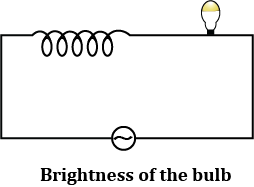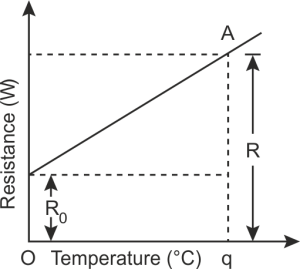Table of Contents

Ans. (b) increase
Explanation:
As the iron rod is removed from the coil, the coil’s self-inductance falls, the circuit’s impedance drops and the current rises as a result. Therefore, the electricity used by the bulb grows, as does the brightness of the bulb.
Ans. (a) current and potential difference
Explanation: Ohm’s law deals with the relation between current and potential difference.
i.e., V∝ I
V = IR
Explanation:
The amount of heat produced by an electric current in time t is given by \\ \text{H = -I}^2\text{Rt} = \dfrac{\text{V}^2\text{t}}{\text{R}} \\[4.5 bp]
\text{i.e. }\space \space \space \text{H ∝ } \dfrac{1}{\text{R}}\\
For the parallel combination, potential difference V is same. As toaster produces more heat,has lower resistance.So The light bulb, which produces less heat, has greater resistance.

Explanation:
(i) Temperature Coefficient of Resistance (α):
The resistance at 0°C is \text{R}_0 and the resistance at temperature θ is R.
The change in resistance is \text{R−R}_0 and the change in temperature is θ−0 = θ.
The temperature coefficient of resistance is given by:
\alpha = \dfrac{\text{change in resistance}}{\text{original resistance × change in temperature}}\\[4.5 bp]
= \dfrac{\text{R - R}_0}{\text{R}_0 × \theta} \\
This equation can also be expressed geometrically using the graph as:
\alpha = \dfrac{\text{OC - OA}}{\text{OA × OE}}\\
(ii) The resistance of a metallic conductor increases with a rise in temperature because, as temperature increases, the thermal energy of the metal ions increases. This causes the ions to vibrate more, which increases the likelihood of collisions between conduction electrons and ions. As a result, the motion of electrons is hindered, leading to an increase in resistance.
Explanation:
EMF = Terminal potential difference + potential difference across internal resistance
ε = V + Ir
A real cell has always some internal resistance, a part of the emf is consumed in doing work against the internal resistance in a closed circuit.
So ε > V or V < ε.
| Chapter No. | Chapter Name |
|---|---|
| Chapter 1 | Electric Charges and Fields |
| Chapter 2 | Electrostatic Potential and Capacitance |
| Chapter 3 | Current Electricity |
| Chapter 4 | Moving Charges and Magnetism |
| Chapter 5 | Magnetism and Matter |
| Chapter 6 | Electromagnetic Induction |
| Chapter 7 | Alternating current |
| Chapter 8 | Electromagnetic Waves |
| Chapter 9 | Ray Optics and Optical Instruments |
| Chapter 10 | Wave Optics |
| Chapter 11 | Dual Nature of Radiation and Matter |
| Chapter 12 | Atoms |
| Chapter 13 | Nuclei |
| Chapter 14 | Semiconductor Electronics: Materials, Devices and Simple Circuits |
| Chapter Wise Important Questions for CBSE Board Class 12 Physics |
|---|
| Electric Charges and Fields |
| Electrostatic Potential and Capacitance |
| Current Electricity |
| Moving Charges and Magnetism |
| Magnetism and Matter |
| Electromagnetic Induction |
| Alternating current |
| Electromagnetic Waves |
| Ray Optics and Optical Instruments |
| Wave Optics |
| Dual Nature of Radiation and Matter |
| Atoms |
| Nuclei |
| Semiconductor Electronics: Materials, Devices and Simple Circuits |
CBSE Important Questions Class 10
ICSE Important Questions Class 10
CBSE Important Questions Class 10
ICSE Important Questions Class 10